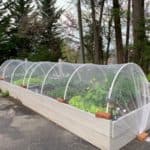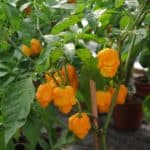Serrano peppers are wonderful. They add so much fresh flavor to salads, sauces, pasta, tacos, and even pizza toppings. Because serrano peppers are a regularly used ingredient in our diet, they are a great pepper to grow in your vegetable garden.
But how long do they take before we can use them and is it worth the wait? There are many factors that determine how long it takes a Serrano Pepper to reach full maturity and to achieve peppers that are full in flavor and bright in color.
A serrano pepper takes about an estimate of 65–80 days to be ready for harvesting, and 80–150 days to reach full maturity, depending on nature’s elements, preparation, transplantation, and proper aftercare of the plant. These factors all play an important role in determining the full time of growth.
If you are wondering how long it will take to grow, you must also be wondering how to go about starting a Serrano pepper garden.
In this article, we will discuss how to plant your serrano seeds and help them grow strong, big, and popping with flavor. You will be able to determine how long it takes a serrano pepper to grow from start to finish!

How To Plant And Take Care Of Your Serrano Peppers?
Serrano peppers can be set to start growing indoors, in about ¼ inch deep in a pot with a good drainage system.
The seedlings need to be kept moist and while they are growing, the best place to keep them when growing indoors is under an artificial light source. The temperature indoors should be between 70 – 75 degrees Fahrenheit.
Growing a Serrano pepper is very similar to growing a Jalapeno pepper. The two are very much alike, with the serrano pepper being a bit smaller and hotter than a Jalapeno pepper.
When your seedlings are ready to be transferred to your garden (after about 8-12 weeks), make sure that they are protected from any frost and pick a spot that will be best suited for your peppers to grow.
Serrano peppers like warm, sunny weather, but if they are exposed to frost, it could kill them.
If you are planting your serrano pepper in a pot, mix your potting soil with mushroom compost and organic matter from your garden.
Be sure to check for any signs of root rot before adding anything to your potting soil. Root rot spreads fast and can contaminate your entire garden
If you are planting them in your garden, create rows that are about 2-3 feet apart and space the Serrano peppers no less than 16 – 18 inches apart in the rows.
As the peppers start to grow, the stems may become too weak to hold them up. When you see that the peppers are getting too heavy, tie stakes to the stems to give them support and protect them from breaking.
You can also add mulch around your serrano plant to help keep the soil damp.
When a serrano pepper is red it indicates that their fully grown and you can go ahead and remove them very gently.
Helpful Tips & Interesting Info on Serrano Peppers
- If the peppers are green, you can harvest them, but they won’t have the full flavor of the mature red serrano peppers.
- If you want the germination process to go quicker, you can soak the seeds for about 12 to 24 hours before you plant them.
- You can water them regularly, but be very careful not to overwater them.
- If you want to achieve bigger peppers at a later stage in the season, you can remove the early blooms.
- Be wary of stunting. This happens when peppers are not transferred from a pot to a bigger garden space in time. These plants aren’t dead, but it grows very slowly, if at all, after it is stunted.
- The serrano pepper has a heat rating of 10,000- 23,000 on the Scoville rating scale.
- The temperature of the soil needs to never drop below 50 degrees Fahrenheit before planting your peppers.
- Serrano peppers flourish in slightly acidic (ph. 5-7), lightweight, fertile soil.
- Never plant serrano peppers next to potatoes or tomatoes. Not even if they have been removed as there will still be traces in the soil.
- Other plants such as kohlrabi, fennel, apricot, kale, cabbage, walnut trees, beans, and brussels sprouts should also be kept away from serrano peppers. These plant types attract similar pests which are very harmful to a serrano pepper plant.
- If you live in a region where sunlight is short during the day, you could always use artificial lighting. Just be careful not to dry out your plants and water daily.
- You can protect your serrano pepper plants from the cold using row covers, but careful they don’t overheat your plants.
- It takes about 2½ months before you should harvest the transplanted peppers. If you harvest them too early, they will be undersized and lacking in flavor.
- If you use a fertilizer that has a high level of nitrogen, it will interfere with the production of the fruit. Rather use a fertilizer that contains a lot of calcium, potassium, and phosphorous.
- By leaving a piece of the stem attached to the pepper while harvesting, it extends the preservation of the pepper.
- Always wear gloves and do not touch your eyes when you are harvesting serrano peppers. They are hot and can cause burning and irritation.
- Insecticidal soap can be used to get rid of pests that are prone to attack serrano peppers. These pests include pill bugs, snails, slugs, flea beetles, whiteflies, and hornworms.
- The plant size can grow up to 36 inches, whereas the pepper size is 1-2 inches in length and +/- ½ an inch thick.

Do Other Types Of Peppers Mature At The Same Rate As Serrano Peppers?
Although all peppers belong to the same family, they have different times of maturity.
This could be influenced by the type of pepper, the difference in climate, the size of the pepper and the region in which it is growing. Here are a few examples of various kinds of peppers and how long they take to mature;
| Type | Description | Days To Mature | Characteristics |
| Serrano Pepper | Bright green and red-colored. Long, glossy, and smooth | 80-150 Days | Jalapeno-like flavor (hot)Originated in Sierras, Mexico. 2nd most popularly used chili in Mexico. Used raw in salsas Pico de gallo |
| California Wonder Bell Pepper | Crisp and fresh+/- 4 x 4 inches Smooth and blocky, usually with 4 lobesThick walls Red, Purple, orange and yellow | 75 Days | Large heirloom Sweet |
| Ghost Chili Pepper/Bhut Jolokia | Small, long pendant shaped (2.5-3.5 inches long; 1 inch thick) Red, orange, or chocolate colored | 120 Days | Hybrid Hottest pepper in the world. Originally from India |
| Anaheim Chili Pepper/New Mexico Pepper/Magdalena | Medium-sized Ripens to dark red/green6-10 inches | 80 Days | Hot, Great for roasting and BBQ |
| Bell Peppers | Red, Yellow & Green. Large | 60-90 Days | Very mild Good in salads, stir-fry’s, or as a pizza topping |
| Goddess Pepper | Starts yellow and turns red when matured. 9 inches long. Banana shaped. Thick flesh | 63 – 85 Days | Used as stuffing, pickling. Sweet & hot |
| Yellow Banana Pepper/Banana Chili/Yellow Wax Pepper | Medium-sized. Bright yellow color – can change to red, orange or green when they ripen | 85 Days | Sweet, mild and tangy. Used as stuffing, pickling & raw in salads |
| Corno Di Toro Pepper | Red & Yellow. Shaped like a bull’s horn | 80 Days | Italian pepper used for frying. Mild |
What Is The Shelf Life Of A Serrano Pepper?
If you are thinking of starting your own serrano pepper garden, just bare in mind that when it is time to harvest, you will have plenty of peppers and they either need to be consumed in 5 days, or you need to preserve them.

Different Ways Preserve Serrano Peppers
Refrigeration – If they are stored in a refrigerator, they can last 1 – 2 weeks. Place the peppers in a plastic bag with a seal and
Room Temperature – If you store your peppers in a fruit basket or pantry at room temperature, they are likely to last up to 5 days.
Freezer – One of the best ways to preserve your serrano peppers, is to place them in the freezer. This will extend the shelf-life up to 6 months.
Dried – By drying your peppers and placing them in a spice mill, you can extend the shelf-life time up to 4 years.
In Conclusion
Now we know that if we take proper care of our serrano peppers, from the start, we are sure to harvest fully matured, full-flavored, juicy peppers in as little as +/- 80 Days.
Serrano peppers are great because they are packed with flavor, but are not too hot and spicy that it will overpower the other flavors in your dishes or sauces, and will make for a pleasant tastebud experience.
Find some fun recipes that include serrano peppers and when you serve them to your friends and family, you can be sure to brag that they are straight from your garden!





